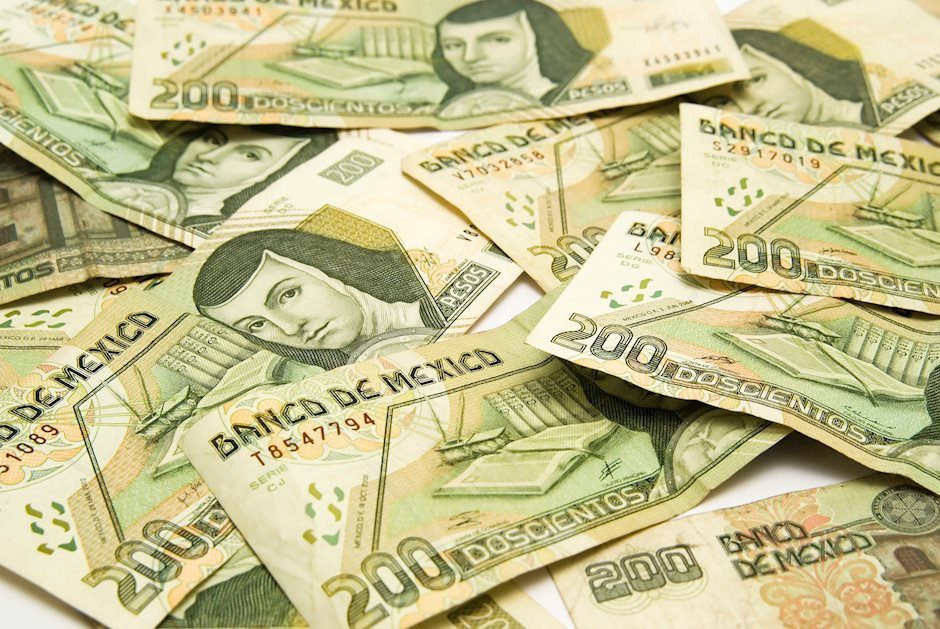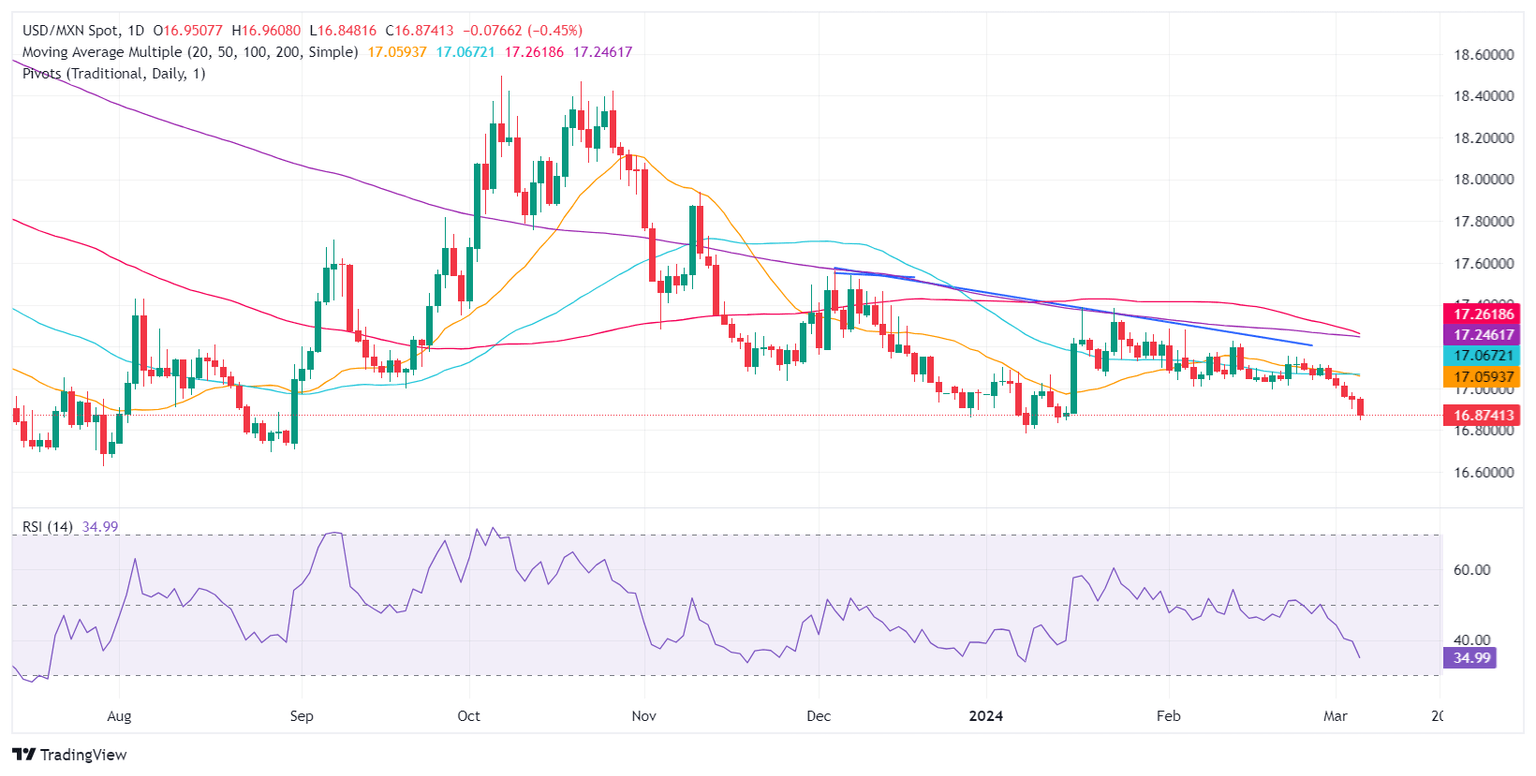Mexican Peso holds to gains against US Dollar on upbeat sentiment
- Mexican Peso soars to seven-week high courtesy of a weak US Dollar.
- Mexico's Consumer Confidence falters, yet Automotive Production and Exports see a rise, reflecting a mixed economic landscape.
- Jerome Powell's Senate testimony hints at no imminent rate cuts.
- US political landscape heats up post-Super Tuesday, with Trump and Biden leading their respective party delegate counts.

The Mexican Peso rallied against the US Dollar during the North American session on Wednesday as US Federal Reserve (Fed) Chair Jerome Powell testified before the US Senate Banking Committee on Capitol Hill. That and soft jobs data from the United States (US) pressured the Greenback and US Treasury yields. Therefore, the USD/MXN exchanges hands at 16.85, plunging 0.91%.
Mexico’s economic docket revealed that Consumer Confidence dipped in seasonal and non-seasonal figures, according to the National Statistics Agency (INEGI). In other data, INEGI revealed that Automotive Production and Exports increased in February from a year earlier.
Across the border, the US Fed Chair Jerome Powell testifies before the US Senate Banking Committee on Capitol Hill. In prepared remarks, he said that interest rates had peaked, that it’s not appropriate to reduce rates soon, and that he has confidence that inflation is moving toward the Fed’s 2% goal.
During the Q&A session, Fed Chair Powell said that rate cuts will depend on data, and that it’s more important to get monetary policy right than to cut rates quickly. He commented that inflation is easing and that there’s no reason to think the economy is in or faces a near-term risk of recession.
Aside from this, the political race is almost defined in the United States after Super Tuesday. Former President Donald Trump leads the Republicans with 995 delegates, shy of the 1,215 needed. On the Democratic side, US President Joe Biden leads with 1,497 delegates, short of the 1,968 needed.
Daily digest market movers: Mexican Peso boosted by broad US Dollar weakness
- According to the data, Mexican Automotive Production increased by 7.76% to 318,735 vehicles and auto exports by 22.62% to 282,608 vehicles.
- Mexico’s consumer confidence index was 47.0 in February when adjusted for seasonal factors, the national statistics agency said on Wednesday. The unadjusted index was 47.1.
- On Monday, Mexico’s economic docket revealed that Gross Fixed Investment in December remained flat MoM. Nevertheless, on an annual basis, it dipped from 19.2% to 13.4%, according to INEGI.
- A Reuters poll sees the Mexican Peso depreciating 7% to 18.24 in 12 months from 16.96 on Monday, according to the median of 20 FX strategists polled on March 1-4. The forecast ranged from 15.50 to 19.00.
- A Reuters poll shows 15 analysts estimate that inflation will slow down in February, corroborating bets that the Bank of Mexico (Banxico) could cut rates as soon as the March 21 meeting.
- The survey showed that the Consumer Price Index (CPI) is expected to dip from 4.88% to 4.42%, while underlying CPI is seen falling to 4.62%, its lowest level since June 2021.
- Mexico’s General Election campaign started on March 1. Polls suggest the ruling party’s nominee, Claudia Sheinbaum, maintains her lead over Xochitl Galvez. Parametria’s poll shows Sheinbaum's support at 49%, while Galvez, the opposition candidate, stands at 29%.
- Banxico’s February private analysts poll projections for 2024:
- General inflation is foreseen at 4.10%, while underlying inflation is expected at 4.06%.
- The economy is expected to grow 2.40%, unchanged from January.
- The USD/MXN exchange rate would end the year at 18.31, down from 18.50.
- Interest rates are expected to be lowered from 11.25% to 9.50%.
- During Banxico’s quarterly report, policymakers acknowledged the progress on inflation and urged caution against premature interest rate cuts. Governor Victoria Rodriguez Ceja said adjustments would be gradual, while Deputy Governors Galia Borja and Jonathan Heath called for prudence. The latter specifically warned against the risks of an early rate cut.
- Banxico updated its economic growth projections for 2024 from 3.0% to 2.8% YoY and maintained 1.5% for 2025. The slowdown is blamed on higher interest rates at 11.25%, which sparked a shift in three of the five governors of the Mexican Central Bank, who are eyeing the first rate cut at the March 21 meeting.
- Economic trade issues between Mexico and the US could depreciate the Mexican currency if the Mexican government fails to resolve its steel and aluminum dispute with the United States. US Trade Representative Katherine Tai warned the US could reimpose tariffs on the commodities.
- US economic data hurt the prospects for a higher USD/MXN, with buyers failing to keep the exchange rate above 17.00.
- February’s US ADP National Employment Report showed that private companies hired fewer people than the 150K expected, with figures increasing by 140K. Nevertheless, the reading exceeded January’s 111K increase.
- The US JOLTS Job Openings report for January came in at 8.863 million, missing estimates and the previous month’s readings of 8.9 million and 8.889 million, respectively.
- As Fed Chair Jerome Powell testifies, the CME FedWatch Tool shows traders increased their bets for a 25-basis-point rate cut in June, from 52.7% a week ago to 59.5%.
Technical analysis: Mexican Peso rally extends as USD/MXN tumbles below 16.90
The USD/MXN downtrend continued, with sellers pushing the exchange rate below the 16.90 figure, opening the door to challenge the current year-to-date low of 16.78, followed by last year’s 16.62. Further downside is seen, once those two levels are cleared, with October’s 2015 low of 16.32.
On the other hand, if buyers reclaim the 17.00 figure, that could open the door to testing the 50-day Simple Moving Average (SMA) at 17.05, followed by the 200-day SMA at 17.24 and the 100-SMA at 17.38.
USD/MXN Price Action – Daily Chart
Mexican Peso FAQs
The Mexican Peso (MXN) is the most traded currency among its Latin American peers. Its value is broadly determined by the performance of the Mexican economy, the country’s central bank’s policy, the amount of foreign investment in the country and even the levels of remittances sent by Mexicans who live abroad, particularly in the United States. Geopolitical trends can also move MXN: for example, the process of nearshoring – or the decision by some firms to relocate manufacturing capacity and supply chains closer to their home countries – is also seen as a catalyst for the Mexican currency as the country is considered a key manufacturing hub in the American continent. Another catalyst for MXN is Oil prices as Mexico is a key exporter of the commodity.
The main objective of Mexico’s central bank, also known as Banxico, is to maintain inflation at low and stable levels (at or close to its target of 3%, the midpoint in a tolerance band of between 2% and 4%). To this end, the bank sets an appropriate level of interest rates. When inflation is too high, Banxico will attempt to tame it by raising interest rates, making it more expensive for households and businesses to borrow money, thus cooling demand and the overall economy. Higher interest rates are generally positive for the Mexican Peso (MXN) as they lead to higher yields, making the country a more attractive place for investors. On the contrary, lower interest rates tend to weaken MXN.
Macroeconomic data releases are key to assess the state of the economy and can have an impact on the Mexican Peso (MXN) valuation. A strong Mexican economy, based on high economic growth, low unemployment and high confidence is good for MXN. Not only does it attract more foreign investment but it may encourage the Bank of Mexico (Banxico) to increase interest rates, particularly if this strength comes together with elevated inflation. However, if economic data is weak, MXN is likely to depreciate.
As an emerging-market currency, the Mexican Peso (MXN) tends to strive during risk-on periods, or when investors perceive that broader market risks are low and thus are eager to engage with investments that carry a higher risk. Conversely, MXN tends to weaken at times of market turbulence or economic uncertainty as investors tend to sell higher-risk assets and flee to the more-stable safe havens.
Author

Christian Borjon Valencia
FXStreet
Christian Borjon began his career as a retail trader in 2010, mainly focused on technical analysis and strategies around it. He started as a swing trader, as he used to work in another industry unrelated to the financial markets.


















